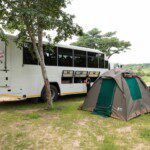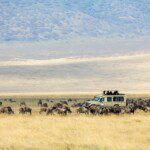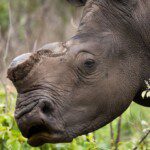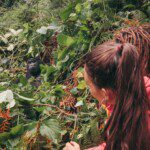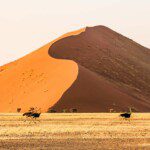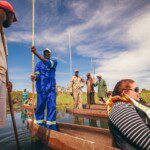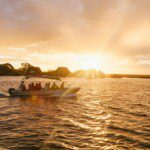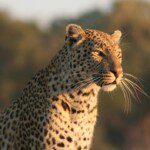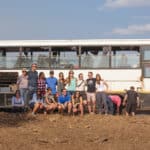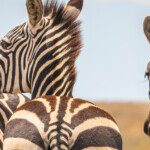Africa Encompassed Southbound
Looking for Africa with the lot? Ask and you'll receive on this epic trip across ten countries in 63 unforgettable days. Get breathtakingly close to animals more often seen in zoos and nature documentaries, from endangered mountain gorillas and lumbering elephants to ferocious lions and tiny dik-dik antelope. Along the way, meet people from various cultures and communities: Zanzibar spice growers, Lake Malawi fishermen and San people. Nairobi to Cape Town and all the adventure in between – this trip will leave you amazed by the breadth of life and culture and the beauty of nature gracing this spectacular continent.
63 days, from
$13,495
per person
GROUP SIZE
ACTIVITY LEVEL
Details
Countries Visited:
Botswana
Kenya
Malawi
Namibia
South Africa
Tanzania, United Republic Of
Uganda
Zambia
Zimbabwe
Accommodation: Camping (with facilities) (48 nights), Hotel (3 nights), Hotel with shared facilities (1 night), Camping (with basic facilities) (3 nights), Bungalow (2 nights), Camping (without facilities) (1 night), Chalet (3 nights)
Transportation: Overland vehicle , 4x4 Safari Vehicle , Ferry , Minibus , Mokoro
Included Meals:
- 58 breakfasts
- 41 lunches
- 50 dinners
Group size: Minimum 1, Max 22
Minimum Age: 15
With permits included in your trip, seek out the rare mountain gorilla on a trek through Uganda's steamy forests and spend an unforgettable hour in their presence.
Get the chance to spot and get close to all of the Big Five and more in Masai Mara National Reserve, Serengeti National Park, Ngorongoro Crater, Etosha National Park and Chobe National Park, among others.
Experience the two sides of Jinja – a riverside retreat at the source of the Nile, but also the adventure capital of Uganda.
Chill out on the northern beaches of Zanzibar enjoying white sand and sparkling blue sea of the Indian Ocean, and cross over to Africa's Atlantic coastline for seafood spreads and dune bashing experiences.
Meet with village communities during your African adventure, including the colourful Maasai tribespeople, the hunter-gatherer traditions of the San communities, and local fisherman on Lake Malawi.
Itinerary
Jambo! Welcome to Kenya. Your Lonely Planet Experience, powered by Intrepid, begins with a welcome meeting at 6 pm, but if you arrive early, why not head out and soak up the cosmopolitan atmosphere of Nairobi. There are plenty of good bars and restaurants, and markets and shops for essentials as well as arts and crafts from the region. After the welcome meeting, perhaps join your new travel companions for an optional group dinner.
Take in spectacular views of the Rift Valley, Lake Naivasha and Elementaita on the drive north-west to Lake Nakuru National Park, situated in the heart of the Great Rift Valley. The drive will take approximately 3–4 hours and you’ll arrive in time for a short evening game drive along the shore of the lake. Lake Nakuru National Park is a small and compact area based around a lake that makes a great location for spotting wildlife. Along with the other members of the Big Five, Lake Nakuru harbours many rhinos and will be the best chance to get a great picture of these magnificent beasts.
Rise early this morning for tea or coffee before going back into the park for a morning game drive. Return to camp for brunch before driving north-west to Eldoret, one of Kenya's fastest growing towns (approximately 5-6 hours.). Due to its high altitude, the town is an ideal training ground for middle- and long-distance athletes and is home to some of Kenya's most famous runners. Tonight, enjoy a traditional dinner at your campsite located just outside of Eldoret town.
Today you will leave Kenya behind and cross the border into landlocked Uganda, travelling on to its capital city, Kampala (approximately 10 hours, though it could take longer depending on border crossings). With a population of over 30 million, Uganda is a country of great cultural diversity and is one of the five countries that make up the East African Community. As today is a long travel day, take a break from setting up camp with a stay at a hotel. After your long drive enjoy a dinner prepared by the hotel before settling in for a good night rest.
Travel to Kalinzu Forest National Park (approximately 9 hours). Some of its inhabitants include chimpanzees, black and white colobuses, baboons, red-tailed monkeys, both blue and red duikers, bushbucks, waterbucks, giant forest hogs, buffalo and elephants. On arrival, settle into your camp and perhaps stretch your legs and explore your surrounds with the rest of the group.
Take the optional excursion of visiting the chimpanzees of Kalinzu Forest this morning or enjoy the sounds of the forest from the comfort of your tent. More closely related to humans than any other living creature, the chimpanzees are a delight to watch as they squabble and play in fruiting trees. Later, take the short drive to Queen Elizabeth National Park. Once camp is set up there's an option to take a boat cruise along the Kazinga Channel, well-known for pelicans, eagles and other wonderful birdlife, as well as a healthy population of hippos.
Today, drive out of the Queen Elizabeth National Park on your way to the southwest tip of Uganda (approximately 7-hour drive). On this short game drive, cross your fingers and look out for elephants, buffalo, Ugandan kobs and waterbucks. When you arrive at the corner of Uganda, where the border touches Rwanda and the Democratic Republic of Congo, you’ll be based in Kisoro, which provides access to seven different gorilla groups located in Mgahinga, Nkuringo, Rushaga and Nshongi.
Joined by a local ranger and gorilla trackers, climb through the rugged mountain terrain of Bwindi National Park to encounter rare gorillas. No more than eight people per day can visit any one habituated family and visits are strictly controlled to minimise disturbance or the chances of transmission of disease to the animals. Tracking gorillas in the dense forest can sometimes be wet, muddy and uncomfortable. The terrain is by no means easy either, so it can be quite strenuous and often humid, but the sheer thrill in coming across a habituated group of gorillas, dominated by a great male silverback, more than outweighs any difficulty. You need to be prepared and fit enough to walk up to four hours – up and down hills. You can usually get very close to the mountain gorillas, who are placid and gentle, and watching their movements is like seeing a mirror image of yourself. Be mesmerised as you watch them eat, sleep, groom and play – the giant silverback surveying the scene as the smaller ones laze in the trees or play like children. Your visit with the gorillas will last one unforgettable hour.
When you are waiting for, or have completed, your gorilla visit, your leader will provide you with options and ideas on how you can spend your free day in the area around Kisoro. You can head out on more rainforest hikes to see monkeys, take some nature walks, or if your legs are up for it, join a challenging hike up Mt Sabinyo – one of five volcanoes located in the Parc National des Volcans – or perhaps take a day excursion over the border to Rwanda to visit the genocide memorial, art museum and Nyamirambo women’s center. However, please ensure you have a Rwanda or East Africa visa.
Farewell the lands of the gorilla and turn back towards the capital, Kampala. You’ll break up the journey at the pit-stop town of Mbarara for the night (approximately 5–6 hours driving). We’ll be honest – there’s not a great deal to do here, however it’s a great opportunity to spend the afternoon and evening relaxing at the camp, or even to have a leisurely look around the town.
Today you'll continue your journey inland, travelling towards Jinja (approximately 7 hrs). The Jinja region is one of the highlights of any visit to Uganda, a riverside retreat at the source of the Nile but also the adventure capital of Uganda. Tonight, camp at a scenic riverside site and enjoy a good night’s rest ready for tomorrow's adventures.
Located at the source of the Nile as it leaves Lake Victoria, Jinja is a place for the adventurer, the adrenaline junkie and the eco-traveller. You’ll enjoy two days here at your own pace, with a bunch of optional activities to choose from (at extra cost) if you want. Maybe get active with some whitewater rafting or kayaking. Alternatively take a boat cruise to the source of the Nile or to enjoy the river and quench a thirst.
Farewell Uganda and begin the journey back to Kenya and Nairobi, stopping overnight at the town of Kericho (approximately 9 hours, including border crossings). Kericho sits at the edge of South-Western Mau National Reserve and is known for its vast tea estates. On arrival, visit a tea plantation and sample a delicious brew or two.
This morning, drive to the famous Masai Mara National Park (approximately 7 hours).
Stop en route in Loita Hills, home of the traditional Maasai people, and visit Tepesua Village. You’ll be welcomed by Maasai Warriors through traditional song and dance. Meet your Maasai hosts and enjoy a fascinating talk, full of insights into this remarkable and ancient culture. Take a walk to the community village which was founded for widows who had lost their cows due to drought and can never remarry. The village offers support, safety and economic growth through the Tepesua Widows Income Project. Here the women are engaged in making handicrafts and sewing eco-friendly handbags and backpacks to sell to visiting travellers and locals.
Travel on to the Masai Mara; a quintessential African experience, with sparse open plains, dramatic skies and the world's most iconic animals living within its boundaries. Explore this diverse environment and view a multitude of wildlife on an early evening 4WD game drive with expert local driver guides.
Venture into the Masai Mara National Reserve with expert local driver guides for a day-long 4WD game drive. You'll explore this diverse environment and most likely see a multitude of wildlife. Plus, an optional balloon ride over the Mara at sunrise is an unforgettable experience. If you have pre-booked this activity you will be picked up before dawn and driven to the launch site for a safety briefing from your pilot. You’ll then glide through the dawn skies, sometimes at tree height, which provides amazing photo opportunities. Sometimes you will ascend, getting an overview of the enormity of the plains and of the early morning movements of the teeming herds. After landing, you'll be treated to a bush breakfast before returning to your campsite.
Say goodbye to the open expanses of the African bush and return Nairobi (approximately 5–6 hours) for a night in a hotel. Beforehand, you'll pass by the remote region of Loita Hills, home of the traditional Maasai people. Here, Maasai people still practice their traditional way of life. Make a stop at Tepesua Village – known for championing Maasai women’s health and education. You’ll be welcomed by Maasai warriors by way of traditional song and dance. Meet your hosts and enjoy a fascinating talk, full of insights into this remarkable and ancient culture, then take a walk to the community village.
Depart early for Mto wa Mbu in your overland truck (approximately 10 hours). The trip includes a border crossing from Kenya into Tanzania, so be sure to have your passport handy. While you're on the road, there will be a stop at an ATM and a market or shop to stock up on any supplies you might need for the coming days. Arrive in Mto wa Mbu and acquaint yourself with this delightful small village – it's a fascinating snapshot of small-town African life, situated well off the tourist trail.
Get up early, put your camping and personal gear into a six-person jeep and head out for an excursion into the Serengeti via the Ngorongoro Crater. Enjoy a safari in the crater, spending 3–4 hours exploring this incredible, perfectly intact volcanic caldera. Watch for black rhinos, lions, leopards, elephants, impalas, zebras and hippos. The crater floor offers excellent game viewing all year round (some 30,000 animals live here) and the photo opportunities are unrivalled. Next, it's on to the wide-open plains of the Serengeti. Green after the rains, brown and burnt in the dry season, this is perhaps the quintessential image of Africa – the home of thousands of hoofed animals and fierce predators. Your campsite is within the Serengeti itself, so listen out for the sounds of nocturnal animals as you drift off to sleep.
Awake at dawn and embark on a game drive. You will head out while the animals are at their most active, then head back to camp for brunch at around 11 am. After spending the middle of the day relaxing, just like the animals do, head out again as the day begins to cool. You'll return from this second game drive in time for dinner. There's also the option of a balloon ride over the park this morning – in place of some of today’s game drives. If you have pre-booked this activity, you will be picked up before dawn and driven to the launch site. After a safety briefing, glide through the dawn, sometimes at tree height, getting some amazing photo opportunities. Sometimes you will ascend, getting an overview of the enormity of the plains and the early morning movements of the teeming herds. After landing, indulge in a five-star bush breakfast, then be returned to camp.
Rise with the sun and enjoy another game drive as you leave the Serengeti in your dust. Jump back into your overland vehicle and head for Mto wa Mbu. Once camp is set up, join the local community for a guided stroll around the farming areas, milling machine, and local homes and farmlands, before a local meal in town.
Prepare yourself for a long travel day heading for the Usambara Mountains (approximately 10 hours). Stretch your legs during a brief supply stop in Arusha, then jump back in the vehicle and watch the ever-changing scenery, read your favourite book or get to really know your fellow travellers. Your base will be Lushoto – an old German colony and home to the Wasambaa people. This highland town sits at approximately 1400 metres and this evening you'll camp in the grounds of one of the oldest hotels in Africa.
Explore the beautiful Usambara Mountains today – a lovely unspoilt area of Tanzania. Unlike the coast and the north, very few tourists visit this part of the country, so it has a freshness that can be hard to find elsewhere. As beautiful as the surrounding mountains and rainforests are, however, the real jewels here are the local people and villages. You'll experience some hospitality on a visit to some of the small local communities. From your base, you will take a walk out to the gorgeous Irente viewpoint. It's best to pack some water and snacks in a day pack for this trip. On your way back, visit a local cultural project based at an Irente farm and enjoy a picnic lunch.
Leaving the mountains behind, travel further south to the coastal town of Kipepeo Beach in Dar es Salaam (380 km, approximately 8–9 hours). Your camp at Kipepeo is by the beach, so make the most of it – perhaps take a stroll along the shore after you arrive and settle in.
Catch a ferry to Africa's 'Spice Island' of Zanzibar. Filled with pristine white-sand beaches, winding cobblestone alleyways and fragrant bazaars, Zanzibar has had a colourful history – everything from slave traders to Arabian sultans and fruit exporters. The sight of traditional dhows sailing along the coast evokes what the island must have been like in centuries ago. The old part of Zanzibar's main city is known as Stone Town, and the best way to see this is on foot, exploring the markets, shops, mosques, palaces and courtyards. When the sun is setting, why not grab a drink from a bar overlooking the seafront. A seafood curry at a local restaurant is also a great choice. You'll spend the night in Stone Town at a basic inn.
Once checked out of your Stone Town accommodation, consider booking in to an optional guided tour of the island's spice plantations, learning all about the history of this town's spice trade. You will have the opportunity to smell and taste various spices, such as cinnamon, vanilla and ginger, plus sample some teas made with these spices too. After lunch, head to the Northern Beaches, where white sands and sparkling blue seas await. This is the Indian Ocean at its best.
Enjoy free time in this beautiful archipelago today. There are many ways you can spend your day – perhaps talk to your leader for any recommendations they might have. Snorkelling in search of exotic fish is an excellent option, or you could take a traditional dhow boat on the water. You might also like to feast on a sumptuous lunch of grilled local seafood, or just relax in a hammock underneath a coconut tree with a good book. It's totally up to you!
Return to Stone Town for a free afternoon and evening getting lost in the labyrinth of backstreets and alleys. Make the most of your evening on the island by treating yourself to some fresh seafood and a sunset drink by the water.
Embrace an early start to catch a 7.30 am ferry to the mainland, then make tracks for Mikumi. It’s approximately an 8-hour drive to your first camp spot, but you’ll get a great look at all that renowned Tanzanian landscape on the way. Gaze out at vast plains dotted with baobab and tamarind trees and maybe catch a glimpse of some of the elephants, buffaloes, giraffes, lions and leopards that call the park home. Once you arrive at your camp spot, your leader will show you the ropes (literally) and help you set up and get comfortable for your night in the tent.
Wake up early this morning to head off on a 4WD game drive into Mikumi National Park with local expert guides. This less touristed park is home to impressive numbers of elephants, hippos, giraffes, zebras, buffalo, warthogs, wildebeest and impalas – and maybe even a predator or two if you're lucky! Afterwards, we'll drive to Iringa (approximately 5 hours) and set up camp on the grounds of a farmhouse on the outskirts of this pleasant settlement. The area is filled with natural bush land which can make it a bird watchers paradise. Make the most of this rural setting by doing some stargazing before you retire for the night.
Enter Malawi and travel to your campsite at Chitimba (approximately 10–12 hours). Malawi, the ‘warm heart of Africa,’ is dominated by its lake, which covers almost a fifth of the country and provides a livelihood for many Malawian people. Fishermen, fish traders and canoe and net makers all ply their trade on Lake Malawi. A common sight is that of a fisherman in a bwato (a dugout canoe made from a hollowed tree trunk) fishing on the still lake at the break of day.
Travel from Chitimba to Kande Beach on the shore of Lake Malawi (approximately 6 hours). There will be a chance to stop at a shop or market for any supplies you might need along the way. Enjoy a relaxing getaway from the commercialism and crowds with a few days on the lake’s more peaceful beaches. Your campsite at Kande Beach is right on the shore of Lake Malawi.
Enjoy free time today and soak up your idyllic surrounds. As well as chilling out on the lake’s sandy shores, make sure you take the opportunity to meet some local Malawians – easily some of the friendliest people in Africa.
Journey through southern Malawi and enter Zambia, continuing to South Luangwa National Park (approximately 9–10 hours). There will be border crossing formalities on the way, and a chance to stock up on goods at a shop or market and visit an ATM. The concentration of animals around the Luangwa River and its lagoons is some of the highest in Africa. Take in the beautiful scenery and the abundance of wildlife, watching out for colourful birds and herds of elephants.
Rise early for an exhilarating morning game drive in a 4WD with a local guide, then head back to the camp for lunch (as this is the hottest part of the day).
Return to the park for another Game Drive late this afternoon
Alternatively, an optional village walk is another good option, if you'd like a snapshot of daily life in the local community.
After breakfast, pay a visit to a workshop where local craftswomen take snare wire recovered from poaching traps and transform it into jewellery inspired by the African bush. The women will show you around their purpose-built workshop and give you a chance to try coiling or hammering the wire yourself. For each sale made, a donation is given to anti snare patrols dedicated to the conservation of the region. After your visit, head further south to Petauke (approximately 6 hours).
Head for your camp just south of Lusaka City (approximately 6 hours). Arrive, stretch your legs and take a stroll to discover the town. Though it's fast developing, Lusaka retains a strong African feel, and the locals are usually up for a chat.
Travel to Harare today (approximately 8–9 hours). The first part of your journey takes you to the border with Zimbabwe. After crossing, continue to Harare. There will be a chance to explore the town, stock up on whatever you need at a market or shop and use an ATM.
Drive to Masvingo (approximately 5–6 hours). This colonial settlement – the oldest in Zimbabwe – makes the perfect base for exploring the ruins of Great Zimbabwe. The ancient city, now a World Heritage site, was first constructed in the 11th century and is believed to have been the seat of power for a monarch. Spend a few hours exploring this intriguing site before heading off to camp.
Travel to Bulawayo (approximately 5–6 hours). Known locally as the 'City of Kings', Bulawayo is Zimbabwe's second largest city. There is some impeccable colonial architecture to take in here. Enjoy free time this afternoon to explore town. You might like to browse some local markets or chat with the locals. The Natural History Museum and National Art Gallery are also worth checking out.
Perhaps get up early and take the option to visit Matobo National Park. Home to a significant population of black and white rhinos, this optional activity gives you the unique experience to track these magnificent animals on foot. There will also be the chance to spot other game – klipspringers, leopards, warthogs and springhares, among others – while learning about local plant and tree species. This impressive wildlife park is also the site of the grave of Cecil John Rhodes – the founder of Rhodesia and the De Beers diamond company. The Matopos area has great spiritual and cultural significance to local San communities, and there are many sites within the park where important ceremonies still take place. Take a short hike to see San paintings and learn about local history and culture.
Depart Bulawayo and make the 6-hour drive towards Victoria Falls. Stretching 1.6 kilometres wide and falling 108 metres into a narrow gorge below, the falls for which the area is named are a sight to behold. Although a visit to the falls themselves is optional, it is highly recommended. The entrance fee to the falls is not included, as groups that book ahead are required to tour the site with a local guide, and we feel that seeing these waterfalls should be an uninterrupted sensory experience. In the wet season, the spray created from this feat of nature can rise 400 metres and can often be seen from kilometres away. It’s no wonder that the local name for Victoria Falls is Mosi oa Tunya, or the 'Smoke that Thunders'. Though dry season travellers should not despair! You’ll get an unobstructed view of the falls and the chance to see the islets in the river below. Your leader will take you to a local activity centre where a range of activities will be on offer.
Spend today by Victoria Falls, with the day free for you to choose your own adventure. You could perhaps book in on one of the optional activities on offer, such as an incredible scenic helicopter flight over the falls. This optional experience is one you won't forget any time soon.
Today you have the option of visiting the magnificent Victoria Falls. Spanning about a mile wide across and falling 108 metres into a narrow gorge below, the spray from the falls can sometimes be seen from kilometres away. In the dry season, the view of the falls is unobstructed by spray and it's possible to see little islets in the river below. To fully understand the sheer force of this staggering curtain of water, it needs to be experienced in person. It's no wonder that the local name Mosi oa Tunya means the 'smoke that thunders'. Alternatively, your leader will be able to recommend a range of other activities that are available.
This morning is free for you to continue enjoying all that Victoria Falls has to offer. Afterwards, travel to Chobe National Park in Botswana (approximately 2–3 hours) via the Victoria Falls Wildlife Trust, one of The Intrepid Foundation’s projects. Here you can learn about the rescue and rehabilitation of wildlife, human-wildlife conflict and the Trust’s role in anti-poaching. There may also be a chance to meet any rescued or orphaned wildlife currently in their care. Continue your journey to Botswana's first national park, which is famous for its high concentration of elephants, so keep an eye out! They can often be seen swimming in the Chobe River.
Rise and shine for an early-morning game drive. Adventuring through the park, you will get the opportunity to get up close to the wildlife – with luck you will spot a variety of animals and any number of exotic birds. As well as the Chobe icon, the elephant, the river also attracts hippos and crocodiles – the latter like to sun themselves by the water's edge. Cheetahs also come down for a drink. The birdwatching is excellent here too – look out for eagles, kingfishers and marabou storks, among hundreds of other species. In the afternoon perhaps take an optional cruise down the Chobe River – one of the best ways to enjoy the park's animals.
Today you will enter Namibia, driving from Kasane to Ngoma Bridge, and on to your camp at Bagani (approximately 7 hours). Bagani is a small, friendly town with some good hiking trails along the river. There are also plenty of nice spots in which you can simply relax and soak up the ambience. This area is the homestead of the local Mbukushu kings. You will have the opportunity to stop at an ATM and a market or shop today. Your camp has flush toilets, showers and Wi-Fi. Upgrades are also available (subject to availability).
Drive across the border into Botswana and head south along the Okavango Panhandle (the narrowest part of the delta) to Seronga. Here you'll leave your vehicle and join your transport for the journey into the delta (approximately 4 hours). Take a boat across the swamps to Gao Island to meet your mokoro team and start exploring the Okavango Delta with them. Each mokoro (small dugout canoe) takes two people and is poled along through the waterways by a local tribesman. Reeds and lily pads line the streams, and birds startled by the mokoros rise out of the long grasses. Punting along, you'll hear hippos occasionally piercing the peaceful atmosphere with their grunts. On the first night here, you'll camp on an island well away from civilisation.
Continue your trip around the delta and then return to Gao Island before heading to the relative civilisation of Umvuvu Camp. This camp usually has hot showers, and there's a small bar at which you can relax and perhaps enjoy a refreshing sundowner. Today there is an option to take a nature walk with your guide. This is a great chance to discover the beautiful natural surrounds, gain some insight into the history of the local area and look out for animals such as giraffe, zebra and elephants.
Cross the border back into Namibia and return to Bagani to camp for the night. Various boat trips, fishing trips and guided hikes are possible from Bagani, so if you're feeling active, get out and make the most of it. Those who are feeling bold might even be able to challenge the local kids to a soccer match – don't expect to win though! Retire to your camp in the evening and enjoy this welcome break from the road.
Drive to your camp situated 50 kilometres outside of Grootfontein (approximately 7 hours). The town of Grootfontein, part of the Otavi Triangle, tends to get very green in the warmer months but dries out markedly in the winter. If it's springtime, you'll likely see jacarandas in bloom.
Embark on a 180-kilometre (112-mile) round-trip to visit the San people. The oldest inhabitants of southern Africa, the San, have lived in this region for at least 20,000 years. Listen to their stories and songs and learn how those who still adhere to a traditional way of life emphasise the importance of living in harmony with the environment.
Travel about 6 hours to Etosha National Park. While Etosha National Park is home to a wide range of southern Africa's wildlife, including the big carnivores and five rare or endangered species: black rhino, Hartmann's mountain zebra, black-faced impala, roan antelope and the tiny Damara dik-dik. Game viewing in Etosha is relatively easy due to the man-made waterholes and the large, sparsely vegetated pans. The bushland surrounding the pans is difficult to see through, but there are enough clearings, pans and waterholes to usually allow for some sightings. Embark on an optional evening game drive here in the evening, then spend the night at Namutoni. Accommodation upgrades are on offer here.
Enjoy a full-day game drive in Etosha National Park. Namibia has protected its game reserves against poaching, which means significant numbers of elephants, antelope and other herbivores reside here. The park is also home to some 340 species of birds – keep an eye to the sky where you might spot a soaring eagle. Tonight, you will stay at the particularly spectacular Okaukuejo Camp. The camp overlooks a floodlit waterhole visited by many different species throughout the day and night. Upgrades are not available at this location tonight.
Travel to the mountain of Spitzkoppe, the 'Matterhorn of Namibia' (approximately 9 hours). The wild lands around this superb granite peak are some of Namibia's most stunning. The mountain itself is 700 million years old and 1987 metres (6519 feet) high. Although you shouldn't try to climb to the top, there are some excellent hikes to do in the area, rich in plant life and with some bush paintings to be found. The Spitzkoppe is known for its stunning beauty and the thousands of ancient Bushmen rock art paintings that are still viewable. Be sure to look out for the sunset from your bush camp this evening – the landscape is known to take on dazzling hues of orange and red.
Continue to the town of Swakopmund (approximately 5–6 hours). Be dazzled by the sight, sound and smell of thousands of olive-coloured seals on the shores of Cape Cross while you're travelling up the eerie Atlantic Coast. You'll be able to stop along the way to access an ATM and market if you need some supplies.
Surrounded by the massive dune fields of the Namib Desert on three sides, and the Atlantic Ocean on the other, Swakopmund is an example of the extraordinary German culture that's found in all major settlements in Namibia. It's worth wandering around town to admire the beauty of the Germanic architecture and take advantage of some excellent souvenir shopping.
Today is another free day to enjoy this fun beachside town. If you're after a dose of history and culture, you can stop in at the lighthouse and visit the Swakopmund Museum. Active types and thrillseekers might like to take advantage of the many outdoor activities on offer – this town is the adventure sports mecca of Namibia.
Drive to Sesriem, your base for exploring the incredible Namib Desert region (approximately 6–7 hours). The most famous part of the Namib Desert is its vast dune fields, the most spectacular of which are found near the Sesriem Canyon. This canyon was formed when the Tsauchab River carved a gorge 30 metres into the gravel deposits about 15 million years ago. Now, the river flows out to the dune fields that stretch for hundreds of miles up the coast and dries up in a clay pan at Sossusvlei. The dunes – the highest in the world – are stunning, with magnificent flaming tones created by the brightly coloured sands.
Wake up before dawn and scramble to the top of the dunes for a dramatic sunrise view across a vast sea of sand. The colour changes are simply incredible and provide a spectacular setting for your brunch. Afterwards you will jump in the back of a pickup truck for a trip to Sossusvlei, the incredible salt and clay pan just nearby (approximately 30 minutes each way). Enjoy some time to explore this incredible and mysterious desert oddity. Later, continue to your camp past the small town of Bethanie (approximately 6 hours). Your camp has basic facilities, with showers, flush toilets, Wi-Fi and optional upgrades.
Check out the town of Bethanie before heading further south into the vast desert lands of Namibia towards Fish River Canyon (approximately 3–4 hours). At 500 metres deep and over 160 kilometres long, Fish River Canyon is one of the very largest canyons in the world. During the dry season, the riverbed tends to dry out completely, leaving only a few puddles. In the wet season, after the summer rains, the river can turn into a spectacular raging torrent. At any time of year there are remarkable photographic opportunities here as you watch the colour of the granite rocks change as the sun goes down.
Departing Fish River Canyon, travel to Noordoewer in southern Namibia (approximately 5 hours). Pitch your tent on the scenic banks of the Gariep (Orange) River, which stretches 2200 kilometres (1367 miles) – the longest river in Lesotho. The river’s source is high up in the Drakensberg mountain range, and it flows into the Atlantic Ocean at Alexander Bay in South Africa. The Orange River is responsible for transporting diamonds and creating the deposits that can be found along the Namibian coast.
Depart your camp first thing in the morning and head to Klawer, a town named after the Afrikaans word for a wild clover blooming after rainfall. The surrounding countryside is beautiful, and if there's time, you’ll have the opportunity to explore some of it. Perhaps take a delightful walk around the nearby mountains and farms before settling in for a relaxing evening.
Head to Cape Town (approximately 5 hours), where your trip ends upon arrival. With its stunning coastline, modern cityscape, nearby mountains and a plethora of vineyards within reach, this is one of Africa's most exciting cities. There's no accommodation provided for tonight, but this can be arranged – please enquire at the time of booking this trip.

